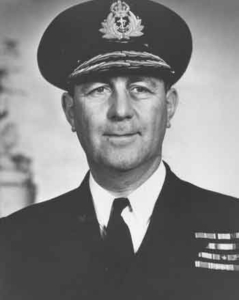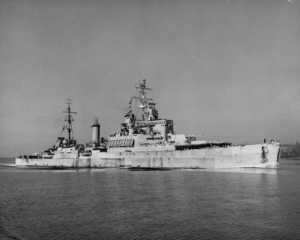Mutiny and cowardice are words that can cast shame upon any warship, especially in a time of war.
Unfortunately, these are words often associated with HMCS UGANDA and her service in the Pacific Theatre during the Second World War.
The notion that a warship would depart an area of operations and set sail for home before a war had ceased is incredible.
On 27 July 1945, however, that is exactly what occurred as UGANDA departed from operations and set sail for Esquimalt. Although rumours of a mutiny and cowardice have ensued, that is simply not the case.
The spring of 1945 found the Allied forces advancing against the Axis powers on all fronts. With victory in Europe only a matter of time, Prime Minister Mackenzie King announced on 4 April that the Canadian Government no longer intended to deploy personnel, other than volunteers, to the Pacific Theatre. The “Volunteers Only” policy, as it was called, required that all naval personnel specifically re-volunteer for service in the Pacific Theatre before they would be dispatched to participate in hostilities. Unaware of the impending policy change, HMCS UGANDA had already set sail to augment the British Pacific Fleet (BPF).
The Canadian cruiser arrived on station on 8 April. Lacking precise direction, she engaged as planned in operations and soon earned quite a reputation. UGANDA was attached to the Fourth Cruiser Squadron, and participated in radar picket, anti-aircraft and shore bombardment duties. Of particular note is her participation in Operation Iceberg, the invasion of Okinawa, for which she was awarded a Battle Honour, and Operation Inmate, where she acted as the Flagship for Rear-Admiral Eric Brind in the British Pacific Fleet’s assignment to destroy air installations throughout the Truk Atoll in the Pacific (now part of Micronesia).
As can be appreciated, the “Volunteers Only” policy change had serious implications for UGANDA, as her commanding officer, Captain Edmond Rollo Mainguy, recognized. If the majority of the ship’s company decided they did not wish to re-volunteer, the operational efficiency of his ship would suffer and his ability to continue to support the British Pacific Fleet would be jeopardized.
The issue came to a head when the ship’s company was required to decide on whether or not they wished to re-volunteer, while simultaneously voting in an advance poll on 2 June for the general election. By nightfall, 344 members of the ship’s company had re-volunteered, while 556 of their shipmates had not. As a result, and due in no small part to the logistical nightmare of trying to send home personnel who opted not to re-volunteer, the Admiralty decided that UGANDA should return to Esquimalt to disembark the non-volunteers. Still, it took some time to organize this, and she continued on operations until relieved by HMS Argonaut on 27 July, when UGANDA departed the Pacific Theatre.
What led two-thirds of the ship’s company to refuse to re-volunteer? This is the question that continues to intrigue historians. While no definitive reason has been identified, it appears that lack of government support acted as a catalyst which, when combined with various personalities, opinions and personal experiences, resulted in what is referred to as the “Uganda Episode”.
The ship’s newspaper, “The Uganda Tar Paper”, noted that only 33.3 % of the crew had previous cruiser experience. As a result, UGANDA’s crew had to learn to adjust to a cruiser’s daily routine, which also entailed a change of mindset in how to carry out their duties. Combined with this learning curve was the Japanese tactic of using kamikaze (suicide) pilots as a desperate form of attack. These suicide attacks were entirely different from any previous combat experiences the crew had survived. As one member of the ship’s company later recalled, “some just wanted to get away from the suicide bomber attacks.”
In his book “Mutiny – The Odyssey of HMCS UGANDA”, Chief Petty Officer James W. Essex commented that as personnel reported on board, many of the ship’s company noted the absence of the Canadian Red Ensign and the maple leaf that should have been displayed on the funnel. This was felt to be an insult to Canada. Although the matter may seem petty, it was significant enough for Captain Mainguy to specifically address the issue with the ship’s company on 22 June.
History has demonstrated that food is always a concern at sea. The Royal Navy was still heavily preoccupied with maintaining its Atlantic lifelines, and found it nearly impossible to properly support the British Pacific Fleet with required spare parts or high quality food. In addition to complaints about food, living conditions onboard UGANDA were uncomfortable and inhospitable, even by the standards of a warship. UGANDA sailed to the Pacific minus onboard exhaust fans for air circulation, and without a water distillation plant capable of supporting the crew.
Aside from poor shipboard living conditions, pressure tactics and family obligations also weighed heavy as the “Volunteers Only” policy became public knowledge in Canada. As a result, the ship’s company was now forced to choose between their families, and their sense of duty, which had compelled most of them to enlist originally.
Pressure to re-volunteer was building. Captain Mainguy waded more directly into the debate prior to the vote with an ill-tempered speech that, according to one crew member’s recollection, “Called us four flushers and quitters. Those who were in doubt soon made up their minds at a statement like that.” One officer recorded this reaction: “That (Captain Mainguy’s speech) finished it.”
Then there was the “Volunteers Only” policy itself. The policy clearly expressed the government’s lack of support for participation in the Pacific Theatre. The ship’s crew had endured almost five years at sea away from loved ones; they had witnessed terrible loss, and ships dying around them; and they had survived dreadful storms across the North Atlantic. One must ask: why would anyone continue to sacrifice and serve their country, if their own government wasn’t committed to the cause?
When one considers the quality of food, living conditions, the lack of a sense of Canadian identity, suicidal Kamikaze pilots, and pressure from the Commanding Officer, combined with lack of government support, it becomes clear that there was no mutiny onboard UGANDA, and that her ship’s company was far from cowardly. Instead, the vast majority of the ship’s company exercised their democratic right as dictated by the government’s “Volunteers Only” policy. Some time later, Mainguy himself noted this perspective, that with no government commitment, there was no guaranteed commitment from her sailors: “The next signal we got fairly shortly was: ‘Do you volunteer to fight against the Japanese?’ It seemed pretty stupid. [There] were those incentives just to be annoyed and say, ‘Well, if we’re not wanted, of course, we don’t want to fight the Japs if it’s not necessary.’ ”
Unfortunately, the perception of mutiny and cowardice associated with UGANDA tends to overshadow the fact that she was the only Canadian warship to actively participate in hostilities against Japan, and that she was held in high regard by the British Pacific Fleet. It is a shame that as we remember the saga of HMCS UGANDA, her contribution to the final victory in the Pacific Theatre has been reduced to remembering that she is the only warship in history known to have voted herself out of a war.


 CFB Esquimalt Naval and Military Museum
CFB Esquimalt Naval and Military Museum CFB Esquimalt Naval and Military Museum
CFB Esquimalt Naval and Military Museum CFB Esquimalt Naval and Military Museum
CFB Esquimalt Naval and Military Museum